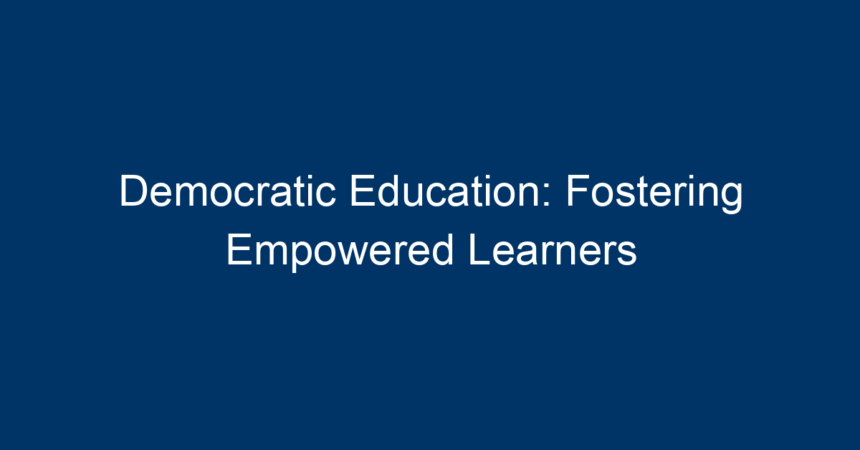In an evolving world, the need for educational systems that prioritize democracy and student agency has never been more pressing. Democratic education is a philosophy that champions the rights of students to have a voice in their own learning. This approach cultivates empowered learners who are prepared to navigate the complexities of modern society, equipped not just with knowledge, but with critical thinking skills and a sense of responsibility. In this article, we will explore the principles of democratic education, its benefits, practices, and how to implement it effectively in today’s classrooms.
What is Democratic Education?
Democratic education is characterized by the active participation of students in their own learning processes. This educational philosophy advocates for student choice, collaboration, and a curriculum that reflects the diverse voices of the community. The fundamental tenet of democratic education is that learning should be a shared journey, emphasizing the importance of both personal and collective growth.
In a typical democratic classroom, the teacher acts not just as an instructor but as a facilitator. This shift allows students to take the reins of their own education, fostering independence and critical thinking. The principles of democratic education are rooted in inclusivity, equity, and mutual respect.
Key Principles of Democratic Education
1. Student Agency
At the heart of democratic education is the principle of student agency. Learners are empowered to make choices about what they learn, how they learn, and even how they assess their own progress. This autonomy not only boosts engagement but also builds self-confidence and fosters a lifelong love for learning.
2. Collaboration and Community
Democratic education values collaboration. Students work in groups, sharing ideas and perspectives, thus enriching their learning experience. By emphasizing teamwork, students learn vital social skills and appreciate diverse viewpoints, preparing them for real-world interactions.
3. Inclusivity
A democratic classroom welcomes all voices. It prioritizes diverse backgrounds and experiences, ensuring that all students feel valued and included. This inclusivity cultivates a supportive environment where learners can express themselves freely.
4. Critical Thinking and Problem Solving
Democratic education encourages learners to think critically and approach problems creatively. Instead of presenting students with factual knowledge, educators guide them to ask questions, conduct research, and derive conclusions. This empowerment helps students develop not just as learners but as thinkers and problem solvers.
Benefits of Democratic Education
1. Enhanced Engagement
When students have a say in their learning processes, they are more engaged. This emotional investment fosters a deeper connection to the material, making learning more meaningful. Engaged students are likely to seek knowledge beyond the classroom, becoming lifelong learners.
2. Improved Social Skills
Through collaboration and group discussions, students enhance their communication and interpersonal skills. They learn to articulate their thoughts clearly, listen actively, and negotiate differences—skills that are invaluable in any societal context.
3. Development of Leadership Qualities
Democratic education nurtures future leaders. By allowing students to make decisions and take responsibility for their learning, they develop essential leadership qualities like accountability, resilience, and vision.
4. Preparation for Civic Responsibility
In an era where democratic values are increasingly challenged, it is crucial for future generations to understand and engage with civic responsibilities. Democratic education equips students with the knowledge and skills necessary to participate in societal issues and advocate for change.
Implementing Democratic Education in the Classroom
1. Create a Collaborative Environment
To foster a democratic classroom, teachers must create an environment that encourages collaboration. This can be achieved through group projects, peer reviews, and collaborative problem-solving activities. By promoting a sense of community, students are more likely to participate actively.
2. Encourage Student Voice
Incorporate opportunities for students to express their opinions and preferences about what they learn. This can be in the form of surveys, class discussions, or suggestion boxes. Making students feel heard increases their investment in their education.
3. Facilitate Choice
Offering choices in learning activities helps cater to diverse learning styles. This could involve presenting several project options, allowing students to choose their reading materials, or even permitting them to set personal learning goals.
4. Foster Critical Thinking
Encourage students to ask questions and apply their knowledge to real-world situations. Incorporate inquiry-based learning where students can explore topics that interest them. This approach not only enhances critical thinking but also cultivates a sense of curiosity.
5. Celebrate Diversity
Acknowledge and celebrate the varied backgrounds and perspectives within the classroom. Use multicultural resources and invite guest speakers from diverse fields. This practice not only enriches the curriculum but also promotes empathy and understanding among students.
6. Reflect and Adjust
Encourage reflective practices among students. Allow them time to consider what works best for their learning processes and what they can improve upon. Teachers should also be willing to reflect on their practices and make adjustments based on student feedback.
Challenges in Democratic Education
While the principles of democratic education hold significant promise, several challenges can arise in its implementation. This includes resistance from traditional education models, varying levels of student readiness for self-directed learning, and the necessity for educators to be well-trained in democratic pedagogies.
Resistance to Change
Some educators may find it difficult to transition from a traditional teaching style to a democratic approach. Professional development and ongoing support can help ease this transition, emphasizing the benefits of student-centered learning.
Varied Preparedness of Students
Not all students come to the classroom equally prepared for a democratic learning environment. Teachers can address this by providing scaffolding support to help students build the necessary skills for autonomy and responsibility.
Resource Limitations
Implementing democratic education may require additional resources, such as materials for collaborative projects or training programs for teacher professional development. Schools must be willing to invest in these resources to ensure successful implementation.
Conclusion: Embracing Democratic Education for Future Success
Democratic education empowers learners, creating a generation equipped to face the complexities of the modern world. By fostering student agency, encouraging collaboration, and promoting inclusivity, we cultivate environments where every student can thrive.
Actionable Insights
-
Start Small: Introduce one democratic practice in your classroom this week and gradually expand as you see positive results.
-
Engage in Professional Development: Seek workshops or training programs on democratic education to better understand its principles and practices.
-
Solicit Feedback: Regularly ask for student input about their learning experience and adjust your practices accordingly.
- Build Community: Facilitate opportunities for families and the wider community to engage in the educational process.
By adopting democratic education, we not only enhance learning outcomes but also prepare our students to be thoughtful, engaged citizens in an ever-changing world. Let us embrace this transformative approach to education for a better future.




